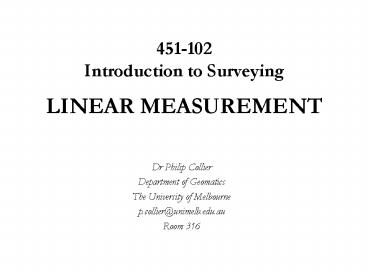451102 Introduction to Surveying LINEAR MEASUREMENT - PowerPoint PPT Presentation
1 / 20
Title:
451102 Introduction to Surveying LINEAR MEASUREMENT
Description:
Distance measuring equipment and typical accuracies. Pacing (1:100) Optical ... Trundle wheel (1:500) Stadia tacheometry (1:1000) Taping or chaining (1:10,000) ... – PowerPoint PPT presentation
Number of Views:3344
Avg rating:3.0/5.0
Title: 451102 Introduction to Surveying LINEAR MEASUREMENT
1
451-102Introduction to SurveyingLINEAR
MEASUREMENT
- Dr Philip Collier
- Department of Geomatics
- The University of Melbourne
- p.collier_at_unimelb.edu.au
- Room 316
2
Linear Measurement
- In these lectures we will cover
- The role of linear measurement
- Equipment
- Procedures and rules
- Errors
- Applications of linear measurement
3
What is linear measurement?
- Simply the measurement of distance
New building site - how big is it?
4
Distance measuring equipment and typical
accuracies
- Pacing (1100)
- Optical range finder (1300)
- Trundle wheel (1500)
- Stadia tacheometry (11000)
- Taping or chaining (110,000)
- Electronic distance measurement (150,000)
- More details on plane surveying web site
5
Some things to note
- Equipment is fairly cheap (except EDM)
- Equipment is easy to maintain and adjust (?)
- Distances are easy to measure
- Very accurate results can be achieved
- Measurement line needs to be unobstructed
- Errors occur and need to be managed or minimised
6
Taping procedures
- Tape must always be straight
- Tape must not be twisted
- Use chaining arrows for intermediate points
- Tape horizontally if possible
- Tape on the ground if possible
- Slope taping needs to be reduced
- Catenary taping requires correction
- Step taping suits some applications
7
Tape must be straight
obstruction
measured distance ? required distance
8
Use chaining arrows
measured distance ? required distance
9
Slope correction
For example s 30.589 m q 2.5o DH 1.334
m then h 30.589 cos(2.5) h 30.560 m
Or. s 30.589 m DH 1.334 m then h
(30.5892 - 1.3342)1/2 h 30.560 m
10
Step taping
11
Catenary taping
measured distance ? required distance
12
Types of errors
These error types apply to any measurement
technique used in surveying
- Blunders
- mistakes and gross errors
- Systematic errors
- repeated size and sign
- affect accuracy
- Random errors
- small and usually undetectable (noise)
- affect precision
13
Accuracy and precision
14
Sources of error in taping
- Temperature correction
- L? L L.c.?T
- where
- L? is the corrected distance
- L is the measured distance
- c 1.15 x 10-5 m/oC (for a steel band)
- ?T Tactual - Tstandard
15
Sources of error in taping
- Standardisation
- The tape is not of true length
16
Sources of error in taping
- Catenary (sag)
- A suspended tape will measure too long
- where
- M is the mass per unit length (0.011 kg/metre)
- g is gravity (9.8 metre/sec2)
- T is the tension (50 Newton)
- ? is the slope angle
17
Sources of error in taping
- Tension
- Tape length will depend on applied tension
- Slope
- Distances must always be reduced to horizontal
18
Applications
- Dimensions of building features
- Block dimensions
- Location and size of site features
- Setting out for construction
- Clearances and tolerances
19
An example
20
451-102Introduction to SurveyingLINEAR
MEASUREMENT
- Dr Philip Collier
- Department of Geomatics
- The University of Melbourne
- p.collier_at_unimelb.edu.au
- Room D316































